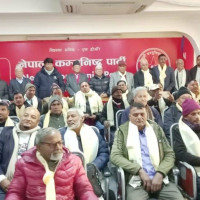- Saturday, 27 December 2025
Rain, rain come along, don’t tarry much too long
Kathmandu, Jan. 29: The seasonal forecast does not show promising signs of precipitation this winter. Almost two months of the season have already passed without sufficient rainfall (no rainfall in the mid and eastern part) indicating the country will have to face severe winter drought.
The frequency of winter drought episodes is not something unprecedented in recent years. Winter rainfall is observed high in the western regions, decreasing from western-central to eastern regions and this year’s trend also shows that only the western part of the country received rainfall.
Within the three months of the winter season – December 1 to February 28, there should have been 60.9 mm of precipitation (3.5 per cent of the annual precipitation) but the country revived only a minimal percentage of the rainfall this year only in the western part of the country with no rainfall in the mid and eastern parts so far.
Insufficient precipitation indicates the drought will be extreme and winter crop production will be badly affected. Overall, the impact of this dry spell and severe drought will be seen in the country's economy, and the farmers will be hard hit, experts said.
Dr. Indira Kandel, a senior divisional meteorologist and chief of the Climate Analysis Section at the Department of Hydrology and Meteorology, shared that the winter season was always dry but the condition had worsened in recent years. The decreasing precipitation and increasing aridity have caused smog and have increased the chances of wildfires in the spring, she added.
Studies also show that the country’s predominantly dry climate is getting hotter and drier. The average annual maximum temperature has increased by 0.056 degree Celsius, according to a study by the DHM.
Effects on winter crops, water sources
Winter crops, including wheat, pulses, mustard, and potatoes require at least light rain to grow. It has been said that the rain from mid-December to mid-January is considered a boon for winter crops. And it’s already late for the crops to grow this year.
Dr. Santosh Nepal, Water Resources and Climate Change Specialist at the International Water Management Institute (IWMI) Nepal Office, said, “I think below-average winter rainfall could seriously impact agriculture, especially rain-fed systems.”
Winter agriculture particularly requires snowfall (in high-altitude areas) and rainfall (low altitude areas) which provide the required soil moisture for crop growth. Lack of soil moisture will hamper agriculture productivity. In Nepal, winter rain did not occur in 2005/06. Because of this, severe and unexpected weather, food shortages occurred particularly in mid-hill districts of Nepal. Mountain districts are particularly sensitive to winter rainfall because of limited irrigation opportunities, Dr. Nepal said.
Similarly, a lack of winter rain may also adversely affect mountain springs and stream flow. A lack of snowfall in the winter season in high-altitude areas can also cause less snowmelt runoff in the early spring season. “Overall, this will affect meltwater-dependent sectors, such as agriculture, livestock production, hydropower and domestic water uses. In the context of climate change, extreme weather patterns like this may happen more frequently in the future,” he added.
Health hazards
Not only for the crops, is precipitation necessary for the better health of people. People living in city areas, including Kathmandu, already face various health hazards due to persistent pollution and lack of rainfall.
According to Dr. Niraj Bam, Associate Professor of the Department of Pulmonology and Critical Care Medicine at TU Teaching Hospital, there was a possibility of an increase in the air quality index (AQI) due to this dry spell. “Patients with allergies, cough, asthma and heart problems are increasing in the hospital due to the dry polluted air.” Problems like burning eyes, irritated nose, sinus, sore throat, wheezing cough and difficulty breathing are some of the problems that increase during the dry season. “If there will is not enough rainfall, the problem is likely to increase,” Dr. Bam said.
Forest fires loss of wildlife
Forest fires have an adverse effect on human health, ecology and the economy. Vehicle emissions and road dust have already crippled human health in Kathmandu Valley and the increase in forest fires during the dry season further increases the risk.
Forests in Nepal have been experiencing irregular wildfire events in recent years during the dry season from November to June every year. In 2021 alone, 6,537 incidents of wildfires were recorded in Nepal. From 2005 to 2022, 119 people lost their lives to wildfires and 987 houses were destroyed in nearby forests, according to the National Disaster Risk Reduction and Management Authority (NDRRMA).
According to Sundar Sharma, Under Secretary of the NDRRMA, from 2011 to 2022, 36,253 incidents of wildfire were recorded in Nepal with the highest number recorded in 2016 at 7,767 incidents. Most wildfires occur as a result of human activity, he added.
Every year, the country is witnessing a number of wildfires throughout but none of the organizations has looked into the watershed condition, loss of wildlife, medicinal plants, or biodiversity. Wildfires can cause secondary disasters like soil erosion, landslide and flood, and also affect aquatic animals, but we have not shown any concern to the issues so far, Sharma said.
In the last week of March 2021, the government had to close down schools due to rising air pollution levels. Authorities also had to cancel domestic flights due to a lack of visibility during that time as the incidence of wildfires was recorded highest in 2021.
Using forest fire data from MODIS sensors, the International Centre for Integrated Mountain Development (ICIMOD) has developed the Forest Fire Detection and Monitoring System for Nepal. The work was jointly carried out in close collaboration with the Department of Forests and Soil Conservation – Ministry of Forests and Environment, Government of Nepal, under the SERVIR Hindu Kush Himalaya (SERVIR-HKH) Initiative at ICIMOD.
Sunil Thapa, Remote Sensing and Geoinformation Analyst-SERVIR Geospatial Solution at ICIMOD, said that there has been no study in regard to the impact on wildlife due to dry spells and forest fires but their habitats are being lost, and their food sources and important herbs are being lost every year. Open burning can cause the growth of invasive species, which impacts native species, he added.
Southwesterly and southeasterly winds bring moisture from the Indian Ocean during the summer monsoon, while winter precipitation is associated with the westerly wind. Winter precipitation also plays an important role to maintain the Himalayan snow and glaciers and also helps to reduce air pollution.
According to Dr. Binod Pokharel, Associate Professor at the Central Department of Hydrology and Meteorology, Tribhuvan University, the system has remained complicated this year. It might not be as cold as in previous years as more than half of the winter season has already passed. “It was due to La Nina (climate patterns in the Pacific Ocean that can affect the weather worldwide), which has reduced the sea temperature in the eastern Pacific Ocean and increased the temperature in the Indian Ocean.

















